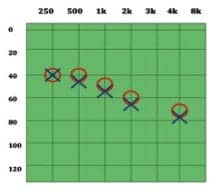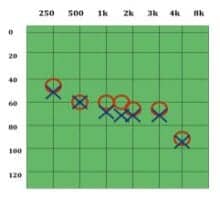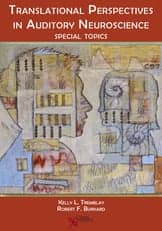Questions about the root causes of a child’s successful hearing habilitation
“Success is not determined by where you are, but rather by how far you’ve come from where you began.”
—Author Unknown
As much and as little as we know about the development of language, each child’s journey toward communication still seems nothing short of miraculous. More so for the hearing-impaired (HI) child. The multitude of factors involved in ensuring successful oral communication for the HI child is overwhelming for parents and perhaps also for the diagnosing pediatric audiologist.
What are the primary factors for ensuring language success for the HI child? Methodical and continued research has indicated age of intervention1-7 as one of the most important. But, with so many additional elements—such as type of amplification and intervention services occurring concurrently—how do we know which of these is truly the most significant or even the exact formula that is right for any particular child? This is the question the author asked numerous times regarding patient R.T.
Case Study of 4-Year-Old Boy
R.T. is a 56-month-old male child with sensorineural hearing loss bilaterally. R.T. did not pass newborn hearing screening. Subsequently, at age 2 months, hearing loss was confirmed. Auditory brainstem response (ABR), otoacoustic emissions (OAE), auditory steady state response (ASSR), and high frequency tympanometry testing was completed, and results were consistent between measures indicating a moderate-to-severe sensorineural hearing loss bilaterally. Earmold impressions were taken, and R.T. was fit with binaural amplification at 2.5 months of age.
R.T.’s first behind-the-ear (BTE) hearing aids (“A”) were 53/125 dB 16-channel DSP devices. Directional microphone programming was available, but not enabled. The noise-reduction option was enabled. Real-ear to coupler difference (RECD) was obtained for each ear, and hearing aids were programmed to DSL targets. Real-ear speechmap verification measures were obtained and within recommended targets.
Three weeks later, after R.T.’s father, who was a ship captain, returned home from a trip, the family visited the office for follow-up. R.T.’s father insisted the hearing aids be changed to something smaller, repeatedly expressing his displeasure with the size of the hearing aids on his tiny son’s ears. He was counseled with regard to the optimal choice for his son; however, he was firmly insistent that smaller hearing instruments be ordered. They were changed to 52/118 dB 7-channel DSP devices (“B”). The noise-reduction algorithm was enabled and directional-microphone option was disabled.
Follow-up with R.T. consisted of changing earmolds every 2 months and behavioral testing beginning at 6 months. After three test sessions, a complete audiogram (Figure 1) was obtained and was consistent with previous electrophysiologic test results. R.T. was receiving home-based auditory training for 30 minutes two times per week, which was the allowance from the county. In addition, R.T.’s mother educated herself extensively regarding language stimulation and enriching R.T.’s language environment. Beginning at 8 months, R.T.’s mother took him to a speech language pathologist with experience in auditory training.
Because R.T.’s father was frequently away from his family, R.T.’s mother took extensive video of him to send to his father. Examining video of R.T. at different time intervals was a way for the author to observe his language development. At 11 months, while R.T. was clearly producing utterances, they consisted mostly of yells, screams, and open-mouth back vowels. No consonants were heard in his repertoire and R.T.’s mother commented that he didn’t produce any.
This was concerning and his hearing was reevaluated. Test results were consistent with previous tests. R.T.’s mother inquired about trying different hearing instruments. The audiologist was interested in readjusting the current instruments to maximize high frequencies.
At 1 year, R.T.’s mother enrolled him in a part-time day care to expose him to multiple typical language models. Consonants began to appear in his utterances at 13 months, and his syllables were typical of canonical babbling. Hearing was reevaluated every 3 to 4 months and was stable with the exception of several episodes of otitis media. Nevertheless, language continued to progress with more spontaneous utterances produced and expansion of consonant repertoire. R.T.’s receptive language skills were improving and better than his expressive language, which research indicates is typical.8,9

Figure 1. First complete audiogram of R.T.
At 24 months, upon the recommendation of the treating pediatric audiologist, R.T.’s mother added therapy with a certified auditory-verbal (A-V) therapist for 1 hour each week. The trip to the A-V therapist was 3 hours round trip and thus only possible once a week. Video from this time indicated that R.T. had more speech-like utterances; however, most were unintelligible to everyone except his mother who seemed to understand about 50%. After 2 months of working with the A-V therapist, it was reported to the pediatric audiologist that R.T. did not seem to be adequately amplified in the high frequencies. R.T.’s hearing was reevaluated, and a decrease in the high frequencies was present in each ear (Figure 2). Adjustment to the current hearing aids did not yield enough gain and new hearing instruments were ordered.
R.T.’s third set (“C”) of 60/125 dB 20-channel DSP hearing instruments were fit at 27 months. The noise reduction algorithm was enabled, and adaptive directionality was enabled in Program 2, which R.T.’s mother could engage in noisy situations. Real-ear speechmap verification measures were completed and targets were matched. On R.T.’s first visit to the A-V therapist post-fitting, a very significant and positive difference in his high frequency hearing was detected. Shortly after this, at approximately 30 months, R.T’s language began to explode and his mom reported that he seemed to add 10 to 15 words to his vocabulary each day! His intelligibility was rapidly improving and 50% of what he said to anyone was intelligible. As all pediatric audiologists would likely agree, this was great news.
Recently, R.T. received a comprehensive speech, language, and hearing evaluation. At age 3 years 11 months, R.T. had +742 receptive words and +596 spoken words on the Cottage Acquisition Scales for Listening, Language and Speech (CASLLS). He had a standard score (SS) of 98 (4 year, 1 month equivalent) on the Expressive Vocabulary Test-2 and a SS of 82 (3 year, 2 month equivalent) on the Peabody Picture Vocabulary Test. The Preschool Language Scale-4 results indicated an auditory comprehension SS of 89, an expressive language SS of 89, and a total language SS of 88 (3 year, 7 month equivalent). Word recognition scores with amplification were 88% with the Word Intelligibility by Picture Identification (WIPI) and 76% using the Phonetically Balanced Kindergarten (PBK) words.
So…What Happened Here?
So, what made the difference for R.T.? Was hearing aid “C” responsible for the change? Was A-V therapy the primary reason for his progress? The author also wondered if R.T. had just hit the critical mass of amplification, therapy, and time such that the inevitable next step was talking. There were numerous variables involved, some more easily examined than others.
Hearing aids. Characteristics between R.T.’s three hearing instruments were compared. Those most notable include attack/release times, number of channels, and noise reduction. Noise reduction was a commonality between all instruments, although different algorithms were used for each. While some have speculated that noise reduction could distort the speech signal and alter perception, especially in children, Stelmachowicz et al10 reported no adverse effects on speech perception for children 5 to 10 years old. These researchers also commented that attention may improve in some children due to a decreased listening effort.
Another variable among instruments was number of independently programmed channels. Warner-Henning and Bentler11 studied number of channels as they relate to compression ratio and release time. Effect of channels was directly related to release time and effectiveness of compression. The greater the number of channels coupled with the fastest release time rendered compression most effective (p 480). Kuk and Marcoux12 reported the greater the number of channels, the better the instrument can match gain needs, providing amplification where needed. R.T.’s instruments varied with respect to channels ranging from 7 to 20. Interesting to note, R.T. was switched from hearing instrument “B” to “C” because “B” could not match gain needs in high frequencies and it had fewer channels.

Figure 2. R.T.’s audiogram at about age 2 years 2 months.
Each hearing instrument varied in terms of attack and release times. Fast-acting wide dynamic range compression (WDRC) is defined by Kuk and Marcoux12 as less than 10 ms attack time and 100 ms release time, while slow-acting is defined as greater than 50 ms attack time and 1000 ms release time. Dillon13 and Souza14 reported slow-acting WDRC allows for more consistent audibility by preserving consonants, while Davies-Venn et al15 reported fast-acting WDRC was reported to be better for low-level speech. While each device did vary in terms of attack and release times, all fell within the category, as defined above, of fast-acting WDRC.
A-V therapy. As characteristics between all three devices do not appear to be divergent enough to account for R.T.’s language breakthrough, perhaps the answer can be found in therapy. Initially, R.T. received 1 hour of intervention per week, increased to 2 hours per week at 8 months. At 24 months, this was increased to 3 hours per week with the addition of A-V therapy. R.T.’s mother received instruction and coaching on language stimulation from each therapist and read copious amounts of information on auditory training. She took every opportunity to stimulate language.
Whereas early intervention, specifically A-V therapy, is known to be beneficial in terms of the development of oral communication in HI children,5,16 Hogan et al17 found a greater rate of language development in HI children after beginning A-V therapy versus before A-V therapy. Since age of intervention and age of amplification varied significantly in this study, it was difficult to characterize optimal time to begin therapy. However, 70% of participants demonstrated average to above-average rate of acquisition of language after 12 months of A-V therapy compared to below-average rate of language development before therapy.
In R.T.’s case, before A-V therapy, his rate of language development was below average. After only 6 months of A-V therapy, his rate of language development was noted to be “remarkable” by his A-V therapist.
Family involvement. The final not-easily-quantifiable factor—and the one that can only be documented anecdotally—is the involvement of R.T.’s mother. She was a constant and consistent positive language model for her child. She actively participated in his therapy sessions and sought information on her own, applying it every day to expand R.T.’s communication skills. In a study by Moeller,2 the importance of family involvement was confirmed as one of the two most important factors to ensure the best possible language outcome. In fact, strong family support was even shown to counteract late identification and late enrollment in intervention services. According to the rating scale used by Moeller, R.T.’s mother would likely rank as a “5”, or ideal, in terms of early intervention involvement.
Thanks to early detection, early intervention, and strong family involvement, R.T. is mainstreamed into a typical preschool and will attend kindergarten in the fall alongside his normal-hearing peers. His language skills are assessed as typical for his hearing and chronological ages.
This is the golden ring that pediatric audiologists strive to achieve. While R.T.’s case appears to be the prototypical success story, there were a complicated set of factors all interacting to enable him to arrive at this point.
We may never know for certain what factor played the biggest role in his communication success. As a rule though, we should continue to remind ourselves that success is not determined by where we are at any given moment, but by how far we’ve come from where we began. ?
Acknowledgement
This case study was originally presented at the Starkey First Pediatric Symposium in September 2010.
References
- Downs MP, Yoshinaga-Itano C. The efficacy of early identification and intervention for children with hearing impairment. Pediatr Clin North Am. 1999;46(1):79-87.
- Moeller MP. Early intervention and language development in children who are deaf and hard of hearing. Pediatrics. 2000;106(3):e43-60.
- Moeller MP, Tomblin JB, Yoshinaga-Itano C, Connor CM, Jerger S. Current state of knowledge: language and literacy of children with hearing impairment. Ear Hear. 2007;28(6):740-53.
- Sinninger Y, Grimes A, Christensen E. Auditory development in early amplified children: factors influencing auditory-based communication outcomes in children with hearing loss. Ear Hear. 2010;31(2):166-185.
- Yoshinaga-Itano C. Benefits of early intervention for children with hearing loss. Otolaryngol Clin North Am. 1999;32(6):1089-1102.
- Yoshinaga-Itano C. From screening to early identification and intervention: discovering predictors to successful outcomes for children with significant hearing loss. J Deaf Stud Deaf Educ. 2003;8(1):11-30.
- Yoshinaga-Itano C, Sedey AL, Coulter DK, Mehl AL. Language of early- and later- identified children with hearing loss. Pediatrics. 1998;102(5):1161-71.
- Moeller MP, Hoover B, Putman C, et al. Vocalizations of infants with hearing loss compared with infants with normal hearing: Part I—phonetic development. Ear Hear. 2007;28(5):605-27.
- Moeller MP, Hoover B, Putman C, et al. Vocalizations of infants with hearing loss compared with infants with normal hearing: Part II—transition to words. Ear Hear. 2007;28(5):628-42.
- Stelmachowicz P, Lewis D, Hoover B, Nishi K, McCreery R, Woods W. Effects of digital noise reduction on speech perception for children with hearing loss. Ear Hear. 2010;31(3):345-355.
- Warner Henning R, Bentler R. The effects of hearing aid compression parameters on the short-term dynamic range of continuous speech. J Speech Lang Hear Res. 2008;51:471-84.
- Kuk F, Marcoux A. Factors ensuring consistent audibility in pediatric hearing aid fitting. J Am Acad Audiol. 2002;13:503-520.
- Dillon H. Hearing Aids. Sydney, Australia: Boomerang Press; 2001.
- Souza PE. Effects of compression on speech acoustics, intelligibility, and sound quality. Trends Amplif. 2002;6(4):131-65.
- Davies-Venn E, Souza P, Brennan M, Stecker GC. Effects of audibility and multichannel wide dynamic range compression on consonant recognition for listeners with severe hearing loss. Ear Hear. 2009;30:494-504.
- Rhoades EA, Chisolm TH. Global language progress with an auditory-verbal approach for children who are deaf or hard of hearing. Volta Review. 2001;102(1):5-25.
- Hogan S, Stokes J, White C, Tyszkiewicz E, Woolgar A. An evaluation of auditory verbal therapy using the rate of early language development as an outcome measure. Deafness and Education International. 2008;10(3):143-67.
Correspondence can be addressed to HR or Erica B. Friedland, AuD at .
Citation for this article:
Friedland E. Was It Amplification or Therapy? A Pediatric Case Study Hearing Review. 2011;18(11): 16-19.






